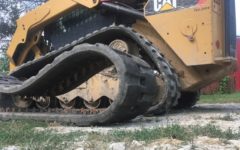

Sep 7, 2021Jerry Mills: Machine maintenance proceeds amid world’s woes
These are strange times. Too hot everywhere, too dry in many places, too wet some places, bumper crops here, no crops there, huge fires, floods, cyclones and hurricanes, ice melting, oceans rising. Not just here, but all over the world.
All while the medics fight a worldwide pandemic with millions of people sick and hundreds of thousands dying.
History tells us we have had plagues and floods, and certainly fires, but all at the same time? There was a plague in the Dark Ages that wiped out half the population of Europe, and there were 400 years of cooler than normal temperature when the atmosphere was clouded with smoke or debris from a meteor strike, or a volcano, but we survived.
The difference, I guess, is that the early calamities happened spontaneously one at a time, and people had no big machines to make them worse. It is not quite the same now, and there are many more of us.
Speaking of machines, I think I have found the perfect tool for leveling ruts and filling mud holes in the orchards. Quick Attach is a small company in Minnesota that makes implements for skid loaders. My newest is a slick bulldozer blade with leveling wheels on the front. The blade turns from side to side with controls inside the cab. This allows moving material from one side of a road to the other.
The wheels extending on the front work the same as a road grader, allowing the blade to grade perfectly level. I had never before been able to do this.
My procedure is to level the ruts as much as possible with a rototiller on the front of the track loader, then bring in a mixture of rocks and soil and dump it, then grade back and forth with the bulldozer, moving and packing the mixture until there is a firm level base. A sprinkle of 1.5-inch rock over the top should do it.
I hope to cobble up a homemade picking platform for picking fruit and pruning fruit trees. If people are going to work on it, that aisle will have to be level and solid. Stay tuned.


Have you ever wondered how to change the tracks on a track loader? This is how my son and I did it. (Mostly son.)
Our loader tracks wore out at 2,500 hours. It seems as if I had just purchased that loader new. Track people say 2,000 hours is normal, so we did get an extra 500 hours. Fortunately, the new tracks were less expensive than a new set of wheels with foam in them. Cost was just over $2,000.
This is how we changed the tracks on a Caterpillar track loader. First, you should know that a cylinder full of grease on each side keeps the tracks tight.
The first thing is to loosen the tracks, and this is how we did it.
1. Blocked up the machine so the tracks were several inches above the floor.
2. Opened small plates on the beams between each side wheel to access the grease fitting on the cylinder inside the beam. Unscrewing the grease fitting allows grease to escape before the fitting is off. Do not remove the fitting entirely.
3. An easy way to compress the tracks is to fasten a nylon strap around them and tighten it using the strap wind-up mechanism. Grease will squirt out as the cylinder is compressed. The front wheel will retract about 2 inches.
4. Elevate and block the track off the drive sprocket.
5. We used penetrating oil and a large impact wrench to unscrew the bolts on the sprocket. A few blows from a heavy hammer loosened the sprocket. It almost dropped off.
6. The track came off by blocking it up and sliding the track over the top of the sprocket hub. The rest of the track followed.
7. Switched the sprockets from one side to the other at this time, so we did not forget. Switching evens out the wear on the sprocket from the new track.
8. To install the new track, we slid it over and under the track rails, blocked up the track to allow replacing the opposite side sprocket, and removed blocks to lower track onto the sprocket.
9. Scooped out excess grease, tightened grease fittings, refilled cylinder with grease until tracks were tight.
10. Lowered loader, started engine and ran a short distance to set the tracks. Used more grease to tighten again. Ran a second time to attain the sag in the track specified in the operators’ manual, and we were finished. We just saved a bunch of money by not having a technician come out to do it for us.
Ominous news from the Atlantic Ocean. This week climate scientists warned there is a serious threat that the Atlantic Ocean Gulf Stream, which pumps warm water from the Gulf of Mexico up our East Coast, east past Greenland and Iceland, and then south offshore from Ireland, Great Britain and France, may be diverted or slowed due to changes in water temperatures.
This would affect weather and temperatures drastically over all of northwestern Europe, as well as northeastern U.S. and Canada, and probably much of the rest of the world. Even more reason to get after climate change.


Gulf diversion not the first time. The first time this has happened was in early 1944, during World War II. The German Nazis secretly built an underwater dam off our East Coast and diverted the Gulf Stream in an effort to hamper the Allied war effort.
Within six weeks, snow completely buried Ireland, Great Britain had heavy snow and blizzards, the English Channel almost froze solid, France came to a stop with ice and snow, and all canals froze, and Spaniards and Portuguese people were suffering from lack of warm clothing. Something drastic had to be done.
In desperation, the Allies called in Superman and he saved the world. He flew through the air, scanning the ocean with his x-ray eyes, spotted the problem, took a deep breath, dove into the water, destroyed the dam and then braced himself and single-handedly diverted the Gulf Stream back to its original course.
I have wondered to this day, what does one push against when in water, pushing against water, and how does one person move so much water without a bucket.
However, this part is all true. I read it in the comics.
— Jerry Mills, Mills Apple Farm














